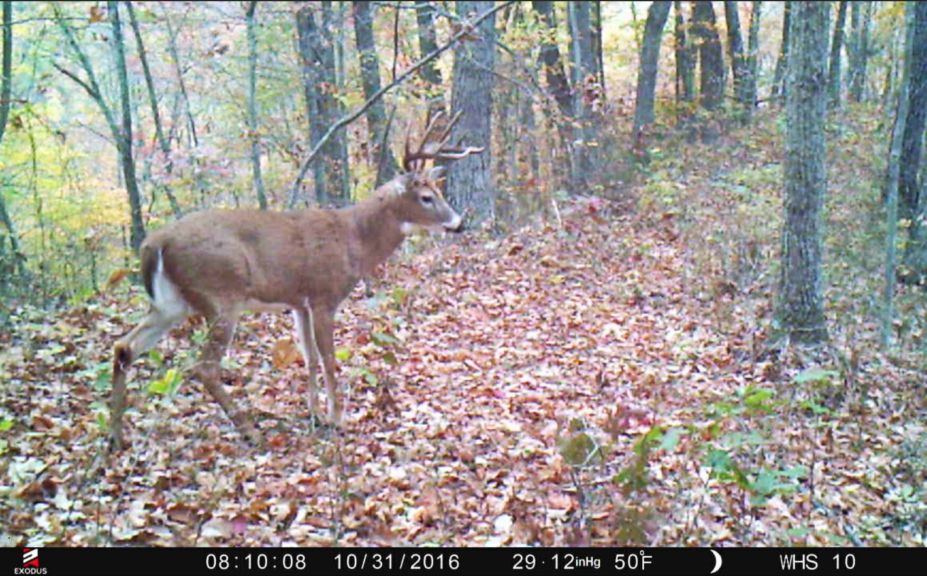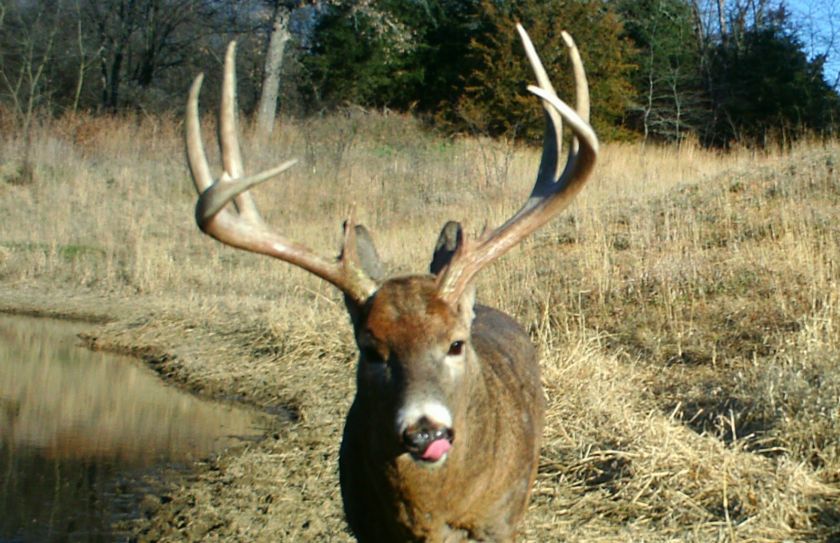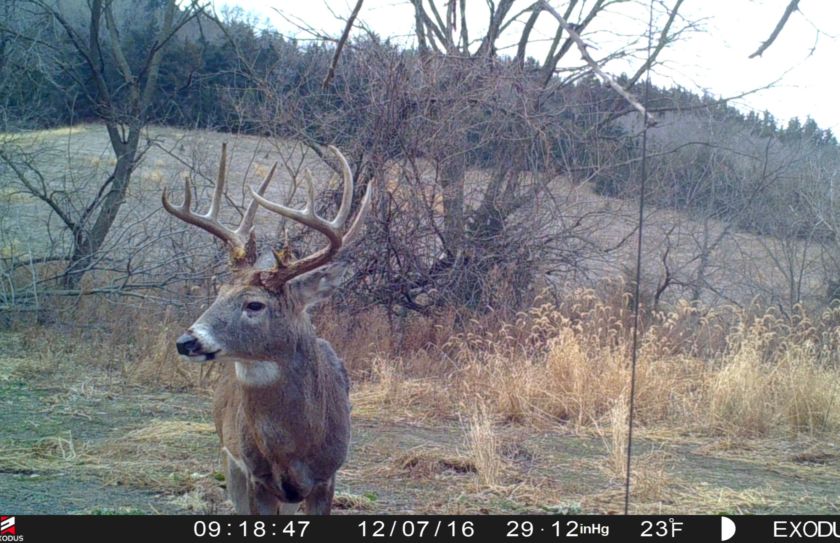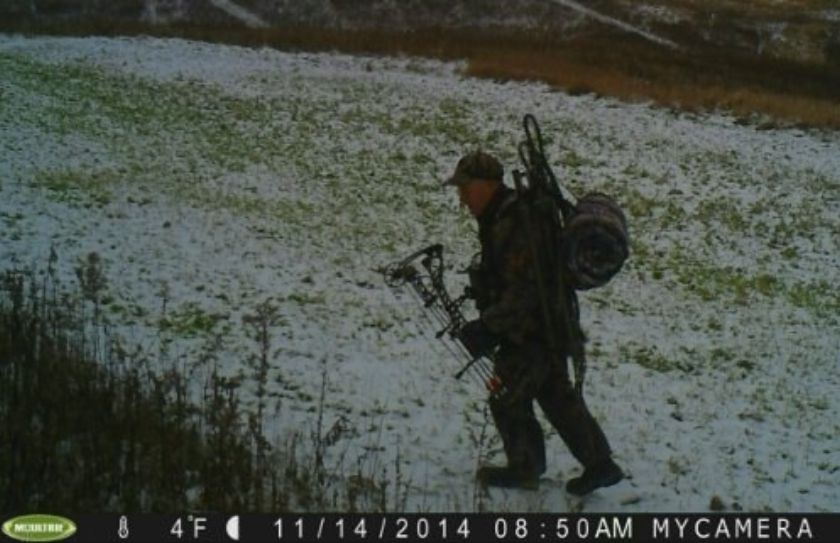The whitetail Peak Rut period during the 3 phases of the whitetail rut can be a significant, "Hit or Miss" adventure. Depending on the land that you are hunting, you may have to rely on both the Peak Rut and Post-rut to kill a mature buck almost exclusively. On the otherhand, if you have mature bucks relating to the area that you hunt as their core area, than your most definitive time to hunt a particular mature buck may have already passed you by, during the Pre Rut. As I described HERE, I love to hunt the Pre Rut. I have experienced that if you let the weather tell you when to sit in a treestand, you can effectively predict when a literal explosion of local mature buck activity will take place. However the Pre Rut's power to produce giants relies on having local bucks to target, that live within or close to the land that you hunt. Many times I have felt the pre-rut bucks I have tagged were spending the bulk of October within 100-200 yards of the stand locations I shot them from. So what if you don't have any local, close bucks to target? Then the Peak Rut is for you!
Whether it's due to the lack of quality Fall cover, Quality Fall food or even that you are hunting the randomness of public land habitat, 100s of thousands of hunters hit the woods during the whitetail Peak Rut each year to try and take advantage of the sometimes distant wanderings of mature bucks during this phase of the whitetail rut. I will also be included within those ranks when I head to OH to hunt public land bucks this year! Large landscapes of random cover and food sources make for honing in on the specific few acres a mature buck may be using during the Pre Rut, similar to the proverbial "needle in a haystack". During the Peak Rut bucks will begin to cruise during brief flurries of activity between does that they are in the process of breeding, and you just never know when one will cruise by. It is a good time to be in a treestand, but is it the best time to slay a monster?

How is the Whitetail Peak Rut Over-rated?
Certainly the Peak Rut is not a bad time to be in the woods! Bucks are truly the beasts of the woods at this time. They are bigger and stronger than any other time of the year, they are ready to breed and they are activitly seeking a doe. At the same time, this is when the majority of does are experiencing estrus, and are receptive to the wanderings of the entire buck population. And that right there folks, is the problem! Mature bucks find a doe fairly easily, and they become locked into a pattern of activity that keeps them within a very tight circle of acreage. A large % of the time during this phase of the whitetail rut, mature bucks are paired with a doe. Our game cam pictures often paint a great picture for us during this time of the season as the # of pictures decrease, in particular the # of mature buck pictures. This is largely due to the fact that each year we have lot of local mature bucks to get pictures of during the Pre Rut and when those bucks are locked into a doe for a few days, they just don't move much. For many lands (the OH public land I will hunt, for example), this is when mature buck pictures begin to actually increase, as bucks begin to leave a doe, and search for another. If your pictures are increasing during the Peak Rut, it may be because mature bucks are leaving adjacent lands to actively cruise for nearby doe family groups on the lands that you personally hunt.
I like hunting during the Peak Rut, but if I had to choose, I would rank this period of time 3rd, behind the Pre Rut first, and Post Rut 2nd. Mature bucks will actively cruise and seek between does, but that time is limited and random. Is that buck you are after locked into a doe a 1/4 mile away, or will he happen to walk by your stand location while between does? Your guess is as good as mine. He could walk by at a much higher % of chance than he could have during early October, but most likely not as definitely as during the Pre Rut.
When Does the Whitetail Peak Rut Begin?
Think of the Pre Rut as the steady drizzle before the storm. A single doe begins her estrus cycle...then another...then a few more...and then bang! A huge % of does in the neighborhood are ready, and command a thunderous boom to begin the Peak of the rut. Each and every year I see the decrease in game camera pictures, scraping activity becomes less frequent and buck movements shrink. In SW WI this occurs in early November, and as ultrasound studies have reflected the date of conception to occur within the same dates each year for given areas, so do my own observations of the "lock-down" that is typical of the Peak-rut. If I had to pick an actual date each year it would be November 3rd for my area, but that of course is merely a guesstimate...and of course only reflective of my experience this region. I believe the central point of the rut each year in the Central UP of Northern MI studies was November 10th, with a huge majority of the does bred within a week to 10 days of that date....but this is a little misleading!
In extreme Northern regions, the whitetail peak of the rut is shorter, and more intense, with the activity levels of the Pre Rut reflecting this as well. Fawns born too early in Northern settings often die because of the harshness of Spring, and fawns that are born too late die due to the extremities of early Winters. Northern whitetails have evolved to produce a very defined rutting period. In SW WI where I hunt, and in southern MI to OH and areas outside of the extremities of the Winter months, the rut is more prolonged and that includes the Pre Rut. Of course I love to hunt the Pre Rut, and I really enjoy experiencing this in some of the more milder climates where the pre-rut can be counted on to last 10 days or more. And like the Pre Rut, I purely hunt cold fronts during the Peak Rut.
How Should You Hunt the Whitetail Peak Rut?
This will begin to sound (and by Part 3 it certainly will!) like a broken record, but I hunt cold fronts, cold fronts and more cold fronts! If it's november 6th, 75 degrees and windy-I stay away from my best stands regardless of the date on the calendar. If I was a TV personality and had to sit virtually every day of the season, well, then I would find a stand somewhere. However, I get to choose the days that I hunt, and do so along with a very strict following of the cold fronts that occur during the various phases of the whitetail rut. The calm, frigid, high pressure days that occur on the backside of every cold front tell me when to hunt, and the expected movements of mature bucks between receptive does tell me where to hunt.
My favorite tactic for hunting the Peak Rut is to take a stand between well-known doe bedding areas during the morning hours, and on the downwind side of food sources during the evening hours. Of course each stand locations is "doe-related", but at the same time I feel that you should have a different focus for morning vs evening sits for the majority of the hunting season, and the Peak Rut is no exception. After the deer clear the fields during the middle of the night to early morning, they are packed back into their bedding areas. Mature bucks know this too! A mature buck that isn't already with a doe at this time of the season will be actively seeking does where they bed. At the same time, a mature buck that is already with a doe in a bedding area, will most likely have to move around within that bedding area to assert his dominance over other bucks that have the intention of stealing that doe for themselves. Whether a mature bucks is displaying his dominance within a bedding area, or cruising doe family group bedding areas looking for his next doe, placing yourself between a couple of mid-day doe hotspots gives yourself an excellent position to intercept both breeding movements. Adding a waterhole to a likely funnel or travel corridor is sometimes a great "quick-stop" precision attraction for your set-up. Regardless of how great your morning set-up is, as the afternoon hours being to take hold you may find that what was a great early morning spot produces fewer and fewer deer sightings, and there is a good reason for that!
During the evening hours, the same mature bucks are likely attempting to control and breed the same does, but virtually every deer in the woods is heading towards their evening food sources. By taking a stand position on the downwind side of a food source you can take advantage of two separate movements as well, similar to your morning stand location.Mature bucks with a doe, can be targeted as they travel towards evening food sources, and mature bucks without a doe can often be found as they cruise parallel strips of cover on the downwind side of a food source. Again, by adding a waterhole your odds for producing precision movements may increase drastically! This cycle of random, hit or miss Peak Rut opportunities can last from a week to 10 days or more, but eventually the pattern is over, and it won't take place for another year.
When Does the Peak Rut End?
If I haven't harvested a mature buck by this point in the season, it will have surely been a grind! Up to 3 weeks of studying the cold fronts, long sits and a general lack of sleep begin to take their toll, but a welcome transition to the 3rd phase of the rut is just around the corner. The Peak Rut ends, when a mature buck experiences an extremely difficult time locating his next conquest. I realize that the rut is about the does and their cycles of estrus, but to me the "Post Rut" phase begins when bucks can't find a receptive doe...and still have the taste for rutting activities. When giant, unfamiliar bucks from distant lands start to show up on your game cams, the Peak Rut is coming to a conclusion.
Conclusion
The randomness of the Peak Rut can create the appearance of incredible breeding activity, or it can leave you scratching your head and wondering, "Where did they all go?" But for the hunter who manages his sits efficiently, and keeps an eye on the weather, bucks are susceptible while actively participating in the rut. Personally, I will definitely be sitting on a bench somewhere within a chunk of public land in OH during this phase of the rut, hoping to catch a monster as he is traveling between doe hotspots, or possibly near an evening ridgetop food source. Experience has taught me that you have to be ready during the Peak Rut, where hours of deminished activity can blow up any minute with a sudden close encounter with a great buck.


